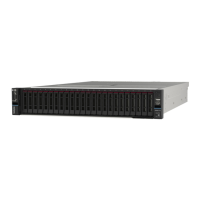In addition, you can take advantage of a memory configurator tool, which is available at the following site:
http://1config.lenovo.com/#/memory_configuration
For specific information about the required installation order of memory modules in your server based on the
system configuration and memory mode that you are implementing, see
the Lenovo ThinkSystem SR950
Memory Population Reference
.
Independent memory mode
Independent memory mode provides the highest level of memory performance, but lacks failover protection.
See
the Lenovo ThinkSystem SR950 Memory Population Reference for independent memory mode
requirements and recommended memory module population sequences.
Memory mirroring
Memory-mirroring mode provides full memory redundancy while reducing the total system memory capacity
in half. Memory channels are grouped in pairs with each channel receiving the same data. If a failure occurs,
the memory controller switches from the DIMMs on the primary channel to the DIMMs on the backup
channel.
See
the Lenovo ThinkSystem SR950 Memory Population Reference for memory mirroring requirements and
recommended memory module population sequences.
Memory sparing
In memory-sparing mode, one memory rank serves as a spare for other ranks on the same channel in case
they fail. The spare rank is held in reserve and not used as active memory until a failure is indicated, with
reserved capacity subtracted from the total available memory in the system. After an error threshold is
surpassed in a system protected by memory sparing, the content of a failing rank of DIMMs is copied to the
spare rank. The failing rank is then taken offline and the spare rank placed online for use as active memory in
place of the failed rank. Since the failover process involves copying of memory content, the level of memory
redundancy provided by memory sparing is less than that provided by memory mirroring: memory mirroring
is the preferred failure-protection choice for critical applications.
See
the Lenovo ThinkSystem SR950 Memory Population Reference for memory sparing requirements and
recommended memory module population sequences.
RAID configuration
Using a Redundant Array of Independent Disks (RAID) to store data remains one of the most common and
cost-efficient methods to increase server's storage performance, availability, and capacity.
RAID increases performance by allowing multiple drives to process I/O requests simultaneously. RAID can
also prevent data loss in case of a drive failure by reconstructing (or rebuilding) the missing data from the
failed drive using the data from the remaining drives.
RAID array (also known as RAID drive group) is a group of multiple physical drives that uses a certain
common method to distribute data across the drives. A virtual drive (also known as virtual disk or logical
drive) is a partition in the drive group that is made up of contiguous data segments on the drives. Virtual drive
is presented up to the host operating system as a physical disk that can be partitioned to create OS logical
drives or volumes.
An introduction to RAID is available at the following Lenovo Press website:
92
ThinkSystem SR950 Setup Guide

